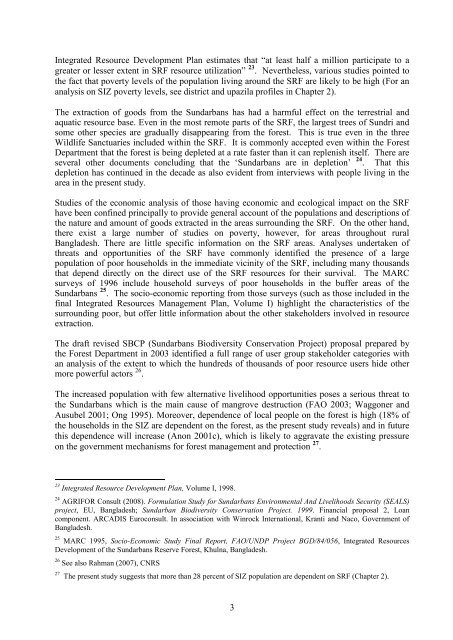INTEGRATED PROTECTED AREA CO-MANAGEMENT (IPAC) - BIDS
INTEGRATED PROTECTED AREA CO-MANAGEMENT (IPAC) - BIDS
INTEGRATED PROTECTED AREA CO-MANAGEMENT (IPAC) - BIDS
Create successful ePaper yourself
Turn your PDF publications into a flip-book with our unique Google optimized e-Paper software.
Integrated Resource Development Plan estimates that “at least half a million participate to a<br />
greater or lesser extent in SRF resource utilization” 23 . Nevertheless, various studies pointed to<br />
the fact that poverty levels of the population living around the SRF are likely to be high (For an<br />
analysis on SIZ poverty levels, see district and upazila profiles in Chapter 2).<br />
The extraction of goods from the Sundarbans has had a harmful effect on the terrestrial and<br />
aquatic resource base. Even in the most remote parts of the SRF, the largest trees of Sundri and<br />
some other species are gradually disappearing from the forest. This is true even in the three<br />
Wildlife Sanctuaries included within the SRF. It is commonly accepted even within the Forest<br />
Department that the forest is being depleted at a rate faster than it can replenish itself. There are<br />
several other documents concluding that the ‘Sundarbans are in depletion’ 24 . That this<br />
depletion has continued in the decade as also evident from interviews with people living in the<br />
area in the present study.<br />
Studies of the economic analysis of those having economic and ecological impact on the SRF<br />
have been confined principally to provide general account of the populations and descriptions of<br />
the nature and amount of goods extracted in the areas surrounding the SRF. On the other hand,<br />
there exist a large number of studies on poverty, however, for areas throughout rural<br />
Bangladesh. There are little specific information on the SRF areas. Analyses undertaken of<br />
threats and opportunities of the SRF have commonly identified the presence of a large<br />
population of poor households in the immediate vicinity of the SRF, including many thousands<br />
that depend directly on the direct use of the SRF resources for their survival. The MARC<br />
surveys of 1996 include household surveys of poor households in the buffer areas of the<br />
Sundarbans 25 . The socio-economic reporting from those surveys (such as those included in the<br />
final Integrated Resources Management Plan, Volume I) highlight the characteristics of the<br />
surrounding poor, but offer little information about the other stakeholders involved in resource<br />
extraction.<br />
The draft revised SBCP (Sundarbans Biodiversity Conservation Project) proposal prepared by<br />
the Forest Department in 2003 identified a full range of user group stakeholder categories with<br />
an analysis of the extent to which the hundreds of thousands of poor resource users hide other<br />
more powerful actors 26 .<br />
The increased population with few alternative livelihood opportunities poses a serious threat to<br />
the Sundarbans which is the main cause of mangrove destruction (FAO 2003; Waggoner and<br />
Ausubel 2001; Ong 1995). Moreover, dependence of local people on the forest is high (18% of<br />
the households in the SIZ are dependent on the forest, as the present study reveals) and in future<br />
this dependence will increase (Anon 2001c), which is likely to aggravate the existing pressure<br />
on the government mechanisms for forest management and protection 27 .<br />
23 Integrated Resource Development Plan, Volume I, 1998.<br />
24 AGRIFOR Consult (2008). Formulation Study for Sundarbans Environmental And Livelihoods Security (SEALS)<br />
project, EU, Bangladesh; Sundarban Biodiversity Conservation Project. 1999. Financial proposal 2, Loan<br />
component. ARCADIS Euroconsult. In association with Winrock International, Kranti and Naco, Government of<br />
Bangladesh.<br />
25 MARC 1995, Socio-Economic Study Final Report, FAO/UNDP Project BGD/84/056, Integrated Resources<br />
Development of the Sundarbans Reserve Forest, Khulna, Bangladesh.<br />
26 See also Rahman (2007), CNRS<br />
27 The present study suggests that more than 28 percent of SIZ population are dependent on SRF (Chapter 2).<br />
3














